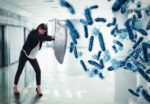Most MAC Lung Infections Not Passed From Patient to Patient, Study Suggests
Written by |

Although person-to-person transmission is possible, most cystic fibrosis (CF) patients infected with Mycobacterium avium complex (MAC) do not share similar strains, according to a study of patients at U.S. care centers.
Researchers found high genetic similarity between isolates of MAC across some people followed at the same CF centers. Nonetheless, most isolates analyzed were unrelated and appeared to be independently acquired.
The data were reported in the study titled “Population Genomics and Inference of Mycobacterium avium Complex Clusters in Cystic Fibrosis Care Centers, United States,” published in Emerging Infectious Diseases, a journal of the Centers for Disease Control and Prevention.
CF patients are susceptible to many different types of lung infections, including with MAC — the most common type of nontuberculous mycobacteria found in people with CF.
MAC pulmonary infections are believed to be most likely acquired via inhalation of aerosols. However, how MAC infections spread among people with CF is not yet fully understood.
To address this question, a team led by researchers at the Center for Genes, Environment, and Health at the National Jewish Health, looked at the genome of 364 MAC isolates from 186 CF patients followed at 42 CF care centers across 23 states. The patients were from 9–88 years old, with an average age of 35 years, and 54% of them were female.
The breakdown of MAC isolates was: 186 M. avium (MAV), 134 M. intracellulare (MINT), and 44 M. chimaera (MCHIM).
About 69% of patients with CF had only one isolate sequenced, 12% had two isolates, and 19% had three or more isolates.
The team used a technique, called whole genome sequencing, to analyze the genome of the different isolates. The researchers then compared sequences and found SNPs, or single nucleotide polymorphisms. SNPs are single nucleotide changes, or mutations, in a DNA sequence.
The researchers established that the threshold for the number of different SNPs representing a genetically related cluster was 20 — meaning that 20 SNPs can still determine a shared recent ancestry among isolates.
Using this threshold, they found a total of 18 genetically related clusters within their study sample, including three MAV, five MCHIM, and 10 MINT clusters.
Within the three MAV clusters, there were two clusters consisting of six patients receiving treatment at one CF care center, and the third cluster was two patients followed at a second care center.
Most patients (56%) within the MCHIM clusters received treatment in the same CF care centers.
In contrast, within the MINT clusters, only a minority (19%) of patients received treatment at the same care center, “suggesting that MINT may have different transmission routes compared with MAV or MCHIM,” the researchers wrote.
In total, 15% of the CF patients (27 out of 186) analyzed had MAC isolates that were genetically similar and received treatment at the same CF care center. Furthermore, “isolates collected within the same center were more similar than isolates collected from the same state,” the researchers wrote, noting the possibility of a certain degree of person-to-person transmission within care centers.
Many of the isolates were, nonetheless, not clustered, indicating a possible transmission through other sources.
Overall, highly similar MAC isolates were found among persons with CF; however, the isolates from most MAC infections appear to be independently acquired and unclustered.
According to the team, more research is needed to fully understand the significance of this finding among CF patients.
“Epidemiologic follow-up will help us understand if genetic similarity is related to acquisition through common geography and environments. Most persons with CF (160/186 [86%]) in our study did not share similar strains; thus, we infer that most persons with CF do not transmit strains person-to-person or share acquisition sources of MAC,” the team wrote.
The data underscores “the need for continued epidemiologic follow-up in patients with MAC lung disease, with and without CF, to assist infectious disease control measures and limit the spread of MAC infections where possible,” the researchers concluded.








